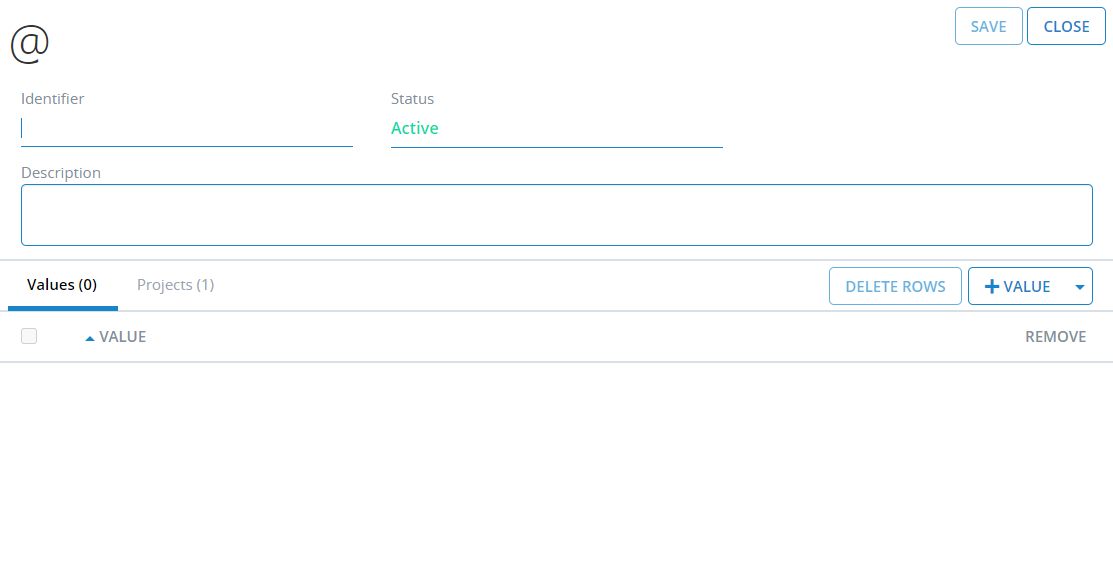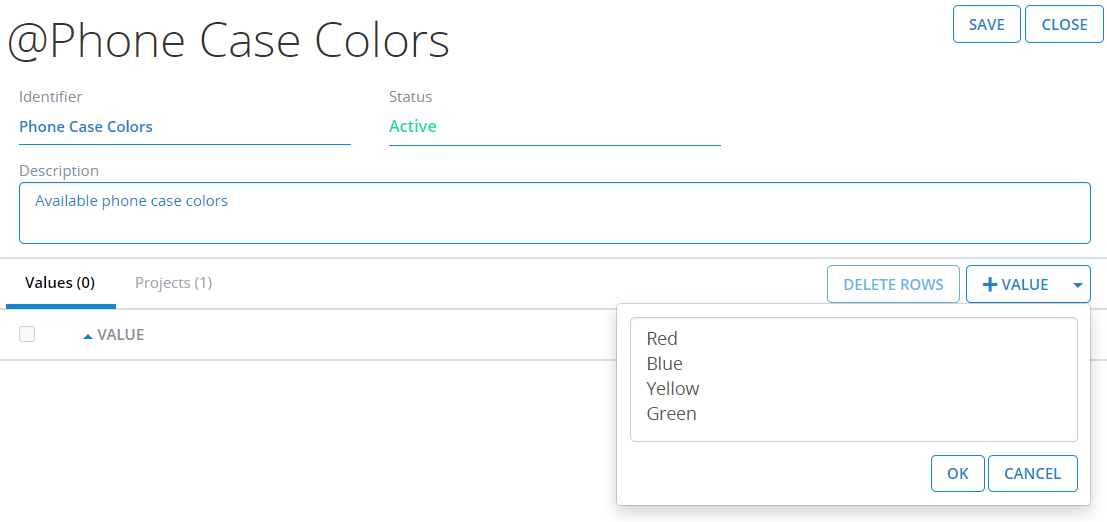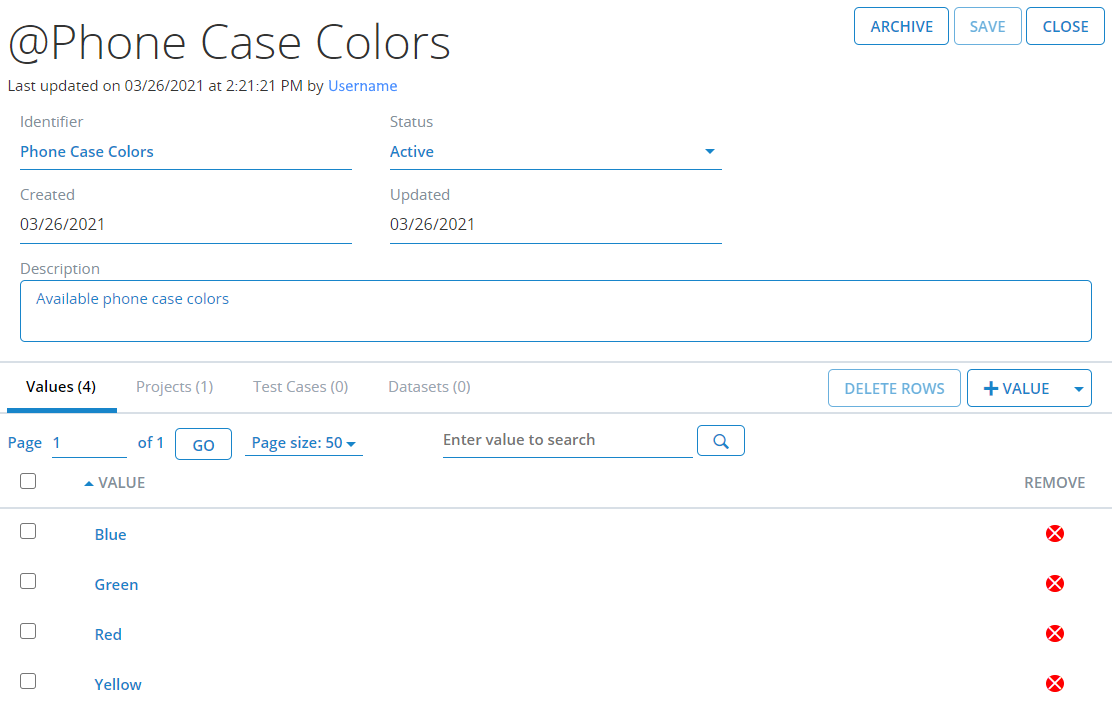Parameters
Sometimes when a new feature is added to your application, multiple variables will be necessary to complete testing on the new feature. Creating separate Test Runs for each of these variables would be time-consuming and repetitive. In qTest, you can use Parameters to generate multiple Test Runs from a single Test Case, saving you time and reducing the number of Test Runs that you need to create manually by centralizing all of the variables that need to be considered for testing. Parameters are the variables defined in Test Steps that help manage test data, functioning as a single placeholder for different values.
For example, suppose your application allows customers to purchase phone cases. For your new release, a new phone case model is released in four different colors. Without using Parameters, you would have to manually create four different Test Runs to test ordering the phone case in each color. Using Parameters, you can create one Test Case that will then automatically generate multiple Test Runs for each color variable.
View, sort, and filter Parameters
-
View Parameters. The Parameters tab is where you can view and manage your existing Datasets.
To access the Parameters tab, access qTest Parameters. The Parameters tab displays by default.

By default, the most recently created Parameters appear at the top of the Parameters tab. Basic information is listed for each Parameters, including whether the Parameter is active and the values that are included in the Parameter.
-
Sort Parameters. To sort Parameters, click a column heading. Parameters will arrange in descending order. Click the column heading again to arrange the Parameters in ascending order. For example, click the Identifier column heading twice to arrange Parameters alphabetically from A to Z.

-
Filter Parameters. You can filter Parameters to display only Parameters that match specified criteria. To filter Parameters, select or make entries in the filter fields, and then click Filter. For example, select Project A in the Project filter and Active in the Status filter to display only Parameters that are active and are associated with Project A.
 Click the Expand icon
Click the Expand icon to display additional filters.
to display additional filters.The following filter fields are available.
Filter Description Project Click the Project filter to search for and select qTest projects. If a Project is selected, only Parameters associated with that Project will display on the Parameters tab. Identifier Enter a Parameter identifier to search for that specific Parameter. Status -
Select Active to display only active Parameters.
-
Select Inactive to display only inactive Datasets.
-
Select Archived to display only archived Parameters.
-
Select All to display all Parameters, regardless of status.
Used -
Select Yes to display only Parameters that are currently being used in Test Execution.
-
Select No to display only Parameters that are not currently being used in Test Execution.
-
Select All to display all Parameters, regardless of whether they are being used in Test Execution.
Note: A Parameter is considered "used" if it is called in a Test Case or a Dataset.
Created Click this filter to display a calendar, where you can select a date. Only Parameters that were created on the selected date will display on the Parameters tab. Updated Click this filter to display a calendar, where you can select a date. Only Parameters that were most recently updated on the selected date will display on the Parameters tab. -
Create a Parameter
To add Parameters to qTest, you can either manually create Parameters or you can import Parameters. The following procedure can be used to manually create Parameters. For a procedure on importing Parameters, refer to Import Parameters.
Once you have created a Parameter, refer to Use Parameters and Datasets for information on using the Parameter in a Test Case.
To manually create a Parameter:
-
On the Parameters tab, click the Create button.

A dialog appears, where you can add information for a new Parameter.

-
On the dialog, enter the following information for the Parameter.
Field Description Identifier Enter an identifier for the Parameter. The identifier is similar to a name. Description Enter a description for the Parameter. -
Next, add values for the Parameter. To add values, click the Value button.
To enter multiple values, press the Enter key after each value. Each value must be separated by a new line. You can enter an unlimited amount of values.

-
Once you have added values, you will need to associate the Parameter to a qTest Project. Associating a Parameter to specific Projects is helpful if you are working on multiple Projects in qTest or if you will have several Projects in the future. If Parameters are not assigned to any Project, they can be difficult to trace for later use.

By default, the Parameter will be associated with all of your qTest Projects. To change the Project associated with the Parameter, click the Projects tab. Then click the Project button, which will display a list where you can select the Projects that the Parameter should be associated with. Click OK to save your selections.
-
On the dialog, click Save to save the new Parameter.
Edit a Parameter
You can modify an existing Parameter, if needed, including the Parameter identifier, status, description, and values.
To edit an existing Parameter:
-
In the Identifier column on the Parameters tab, click the identifier of the Parameter that you want to edit.

A dialog appears, where you can edit the Parameter information.

-
Edit the existing information, as needed.
Option Action Rename a value Click the value name. The value will appear in an editable text box, where you can enter a new name. Delete a value To delete an individual value, click the Remove icon  for that value. You can also delete multiple values by selecting the check boxes for the values you want to delete and then clicking the Delete Rows button.
for that value. You can also delete multiple values by selecting the check boxes for the values you want to delete and then clicking the Delete Rows button.Change the Parameter status In the Status field, select whether the Parameter should be active or inactive.
For more information about setting the status of a Parameter, refer to Archive, delete, activate, or deactivate a Parameter.
Archive a Parameter Click the Archive button to archive the Parameter.
For more information about archiving Parameters, refer to Archive, delete, activate, or deactivate a Parameter.
For information about the remaining fields and options on this dialog, refer to Create a Parameter.
-
On the dialog, click Save to save your changes.
View Test Cases and Datasets associated with a Parameter
You can view a list of the Test Cases and Datasets that a Parameter is currently being called in.
To view associated Test Cases and Datasets, click the identifier of the Parameter that you want to view associations for in the Identifier column on the Parameters tab. The following dialog appears.

Test Cases and Datasets are listed on their respective tabs.
-
View Test Cases. To view associated Test Cases, click the Test Cases tab. The Test Cases that are currently calling the Parameter are listed.

From the Test Cases tab, you can access the following information by clicking the links in each column.
Column Access Project Click the link in the Project column to access the Project screen on the Test Plan tab in qTest Manager. Test Case ID Click the link in the Test Case ID column to access the Test Case screen on the Test Design tab in qTest Manager. Name Click the link in the Name column to access the Test Case screen on the Test Design tab in qTest Manager. -
View Datasets. To view associated Datasets, click the Datasets tab. The Datasets that are currently using the Parameter are listed.

From the Datasets tab, you can click the name of a Dataset to display the Dataset dialog.
Archive, delete, activate, or deactivate a Parameter
It may be the case that some Parameters may not be useful for the time being but may be useful at some later point for an upcoming Project. You can change the status of a Parameter to activate or deactivate the Dataset, as needed.
You can also archive or delete a Parameter if it is no longer needed. Sometimes a Parameter may have been falsely created or you simply may no longer require it. Archiving a Parameter allows you to store the Parameter for informational purposes, while deleting a Parameter removes it from the qTest system.
-
Archive. To archive a Parameter, click the Action icon
 for the Parameter. On the menu that appears, click Archive. You cannot re-activate a Parameter once you have archived it.
for the Parameter. On the menu that appears, click Archive. You cannot re-activate a Parameter once you have archived it. -
Delete. To delete a Parameter, the Parameter must first be archived. Once you have archived the Parameter, click the Action icon
 for the Parameter. On the menu that appears, click Delete.
for the Parameter. On the menu that appears, click Delete. -
Activate. To activate a Parameter, click the Action icon
 for the Parameter. On the menu that appears, click Activate.
for the Parameter. On the menu that appears, click Activate. -
Deactivate. To deactivate a Parameter, click the Action icon
 for the Parameter. On the menu that appears, click Deactivate.
for the Parameter. On the menu that appears, click Deactivate.
Related Topics
| Parameters Quick Start Guide |
| Use Parameters and Datasets |
| Import and Export Parameters |
| Datasets |